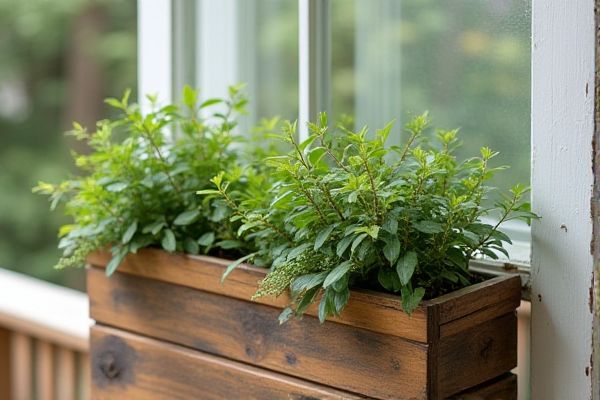
Wall planters save space by attaching directly to vertical surfaces, ideal for small areas, while balcony railing planters provide stable, elevated planting options that enhance outdoor views. Discover the key differences and choose the perfect solution for your gardening needs by reading the rest of the article.
Table of Comparison
| Aspect | Wall Planter | Balcony Railing Planter |
|---|---|---|
| Installation | Mounted directly on walls using hooks or brackets | Clipped or hung over balcony railings |
| Space Utilization | Optimizes vertical wall space | Utilizes railing edges, saving floor space |
| Stability | High stability if securely fixed to wall | Dependent on railing strength and clip security |
| Plant Types | Suitable for trailing and compact plants | Ideal for flowering plants and herbs |
| Exposure to Sunlight | Can be placed according to wall orientation | Typically receives unobstructed sunlight |
| Maintenance | Easier to water without spillage | Requires careful watering to avoid drips |
| Aesthetic Appeal | Creates green walls and vertical gardens | Enhances balcony outline and outdoor view |
| Weight Capacity | Supports heavier planters if wall anchors used | Limited by railing load and clip strength |
Introduction to Wall Planters and Balcony Railing Planters
Wall planters offer a versatile solution for vertical gardening by attaching directly to interior or exterior walls, maximizing space without occupying floor area. Balcony railing planters are designed to securely hang over railings, making them ideal for small outdoor spaces like apartments or balconies, providing easy access to sunlight. Both options enhance greenery in limited areas while catering to different mounting preferences and spatial constraints.
Key Design Differences
Wall planters attach directly to vertical surfaces, offering a sleek, space-saving design ideal for maximizing small areas, while balcony railing planters secure to horizontal rails, providing stability and easy access for watering and maintenance. Wall planters often feature shallow, vertical growth spaces suited for cascading or compact plants, whereas railing planters are typically deeper, designed to support a wider variety of plants with more root space. Understanding these key design differences helps you choose the best option to enhance your outdoor garden efficiently.
Space Efficiency Comparison
Wall planters maximize vertical space by attaching directly to walls, making them ideal for small areas where floor space is limited. Balcony railing planters utilize railing edges to save ground space while providing easy access for watering and maintenance. Your choice depends on the available space and desired accessibility, with wall planters offering higher space efficiency in compact environments.
Installation and Setup Requirements
Wall planters require secure mounting with heavy-duty anchors or screws suitable for the wall material, often necessitating drilling into brick, concrete, or wood surfaces. Balcony railing planters come with adjustable brackets or hooks designed to fit various railing widths, enabling tool-free or minimal tool installation for quick setup. Both planter types benefit from proper weight distribution to avoid structural damage and ensure long-term stability.
Aesthetic Appeal and Style Options
Wall planters offer a sleek, modern aesthetic that complements minimalist and contemporary designs, maximizing vertical space with clean lines and customizable arrangements. Balcony railing planters provide charm and versatility, enhancing outdoor spaces with a variety of styles such as classic wrought iron, rustic wood, or colorful plastic options. Both types allow for creative expression, but wall planters emphasize a streamlined look while railing planters contribute to a more traditional or eclectic ambiance.
Suitability for Different Plant Types
Wall planters are ideal for growing trailing and cascading plants like ivy, ferns, and herbs, offering vertical space that enhances growth and display. Balcony railing planters suit compact or flowering plants such as petunias and succulents, benefiting from direct sunlight and easy access for watering. Your choice depends on the plant species' growth habits and light requirements to ensure optimal health and aesthetics.
Durability and Material Choices
Wall planters are typically made from durable materials such as treated wood, metal, or high-density resin, offering strong resistance to weather and UV exposure, which ensures longevity in various climates. Balcony railing planters often utilize lightweight materials like plastic or metal with coatings to prevent rust and corrosion, designed to withstand wind and moisture while securely attaching to railings. Both types prioritize durability, but wall planters generally offer more robust structural integrity, whereas railing planters focus on ease of installation and materials suited for exposure to dynamic balcony environments.
Maintenance and Watering Accessibility
Wall planters require careful irrigation to prevent water damage to walls and often need drip irrigation systems for consistent moisture, while balcony railing planters offer easier access for watering and maintenance due to their open placement. Balcony railing planters are more convenient for routine care and allow excess water to drain freely, reducing the risk of overwatering. Wall planters may demand more frequent inspection for drainage and structural safety, impacting overall upkeep.
Safety and Structural Considerations
Wall planters require secure mounting with heavy-duty anchors to ensure stability and prevent falling hazards, making them ideal for solid surfaces like brick or concrete walls. Balcony railing planters must be carefully selected for compatibility with railing thickness and strength, using clamps or brackets that distribute weight evenly to avoid damaging or tipping the railing. Both planter types should be evaluated for load capacity to maintain structural integrity and ensure safety for residents and passersby.
Cost-Effectiveness and Value for Money
Wall planters typically offer greater cost-effectiveness due to their easy installation and use of vertical space, reducing the need for additional support structures. Balcony railing planters may incur higher costs because of specialized brackets and potential maintenance from exposure to weather, but they provide valuable space-saving benefits and enhanced aesthetic appeal. Considering long-term value, wall planters maximize budget-friendly greenery without sacrificing functionality or design.
 homyna.com
homyna.com